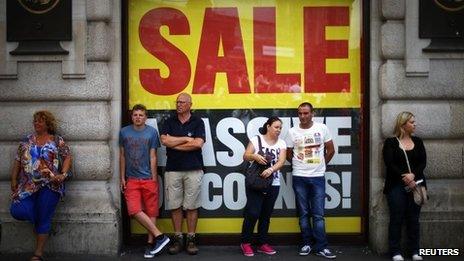UK retail sales figures explained by ONS
- Published

Retailing makes up just over 5% of the economy
Anyone pushing through the Christmas shopping crowds can see the scale of retailing in the UK. Online, out-of-town and on the High Street, shops and stores employ nearly three million people and account for a significant chunk of the economy.
Retailing is also seen as a unique indicator of consumer confidence. If people are spending money in the shops, says conventional wisdom, the economy as a whole must be on the up.
But how does the Office for National Statistics (ONS) measure such a huge and diverse sector and why should those figures be taken seriously?
The Retail Sales Index, produced monthly by ONS, is the most comprehensive survey of retailers, covering 95% of known turnover across the retail industry.
ONS asks 5,000 businesses across England, Wales and Scotland - including supermarkets, clothes stores, market stalls and online retailers - to provide their retail sales turnover for a particular period.
The figures are released midway through the following month, making the Retail Sales Index one of the earliest short-term measurements of the UK economy to be produced.
Data, not sentiment
The figures released provide an estimate of how much was spent (value) and how much was bought (volume) from British retailers. Further estimates of the amount spent online are also provided.
.jpg)
Kate Davies is the statistician for retail sales at the Office for National Statistics
Accounting for 5.7% of gross domestic product (GDP), retail sales are used by the government, the Bank of England and the City of London as a key source of economic intelligence.
So it is essential for such an important and widely used measure to be credible and trusted. ONS produces the index independently of commercial or political influence, so users can be sure that the figures are presented without spin or bias.
It is also important that the figures are based on hard data - money in the tills, not sentiment or expectation.
So what have the figures been telling us? A good example in recent years has been how shoppers' habits have changed since the emergence of online retailing.
The online sector has seen significant growth, doubling its share of the market in the past five years. By October 2013, it accounted for around 10% of all retail sales in Britain with an average weekly spend of just over £650m.
Seasonal adjustments
As well as long-term trends, the Retail Sales Index can also show the volatility of the retail industry and the factors that can cause fluctuations in figures month-on-month.

While people enjoyed a mild October, it meant they delayed their winter purchases
For example, the entire index showed a fall of 0.7% in October, compared with September. Analysis of this data showed that the dip may have been due to milder weather conditions that we experienced during that month - which meant a delay in the number of people going out to buy their winter coats!
These seasonal effects can be measured even more accurately by the method of "seasonal adjustment". This means patterns that occur at a similar time each year - for example, the Christmas shopping rush - are removed.
This "smooths" the peaks and troughs from the numbers, and allows ONS to analyse and better explain monthly variations in the data.
At this frenetic time of year, it's just a pity that moderating influence can't be transferred to the shops themselves!
The opinions expressed are those of the author and are not held by the BBC unless specifically stated. The material is for general information only and does not constitute investment, tax, legal or other form of advice.